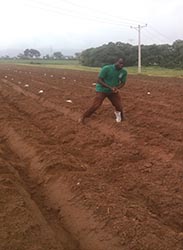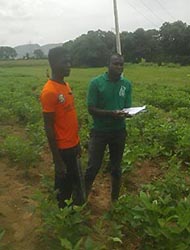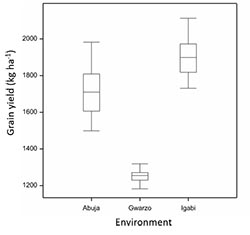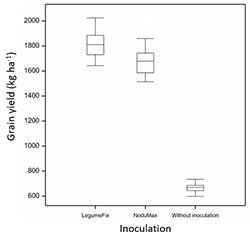Soyabean (Glycine max L.) is the world’s important food legume of great nutritional value. The crop has the highest protein content (40%) of all food crops and is equivalent to proteins of animal products. The crop holds considerable potential for arresting soil fertility decline and enhancing household food nutrition. Therefore, this study aimed at exploiting soyabean genotypes for yield under Rhizobia inoculation across three locations in the Savanna Region of Nigeria.
Methodology
In this study, 24 soyabean genotypes including five commercial checks were evaluated across three different agro-ecological zones in Northern Nigeria. These environments differed in terms of soil pH, nitrogen, available phosphorus and potassium. The inoculants LegumeFix and NoduMax were used in each location. Inoculation was assessed at three levels; without inoculation, with Legumefix and with Nodumax. This therefore resulted in 72 (24 x 3) treatment combinations. A split-plot design with three replications per treatment was adopted at each location, resulting in a total of 216 (72 × 3) sub-plots. The main plots consisted of the soyabean lines and the sub-plots were the inoculant applications.
 |
Figure 1. (Left) Planting of soyabean seed for the purpose of germination and emergence for seed vigour testing by Kehinde Tolorunse (Right) Data collection on the field by Kehinde Tolorunse and Sunday Joshua |
 |
Results
There were significant differences in emergence percentage, number of leaves, height, chlorophyll content, branches per plant, pods per plant were observed except days to 50% flowering, for the different inoculation treatments. Inoculation significantly influenced grain yield and LegumeFix inoculation treatment recorded the best mean performance, followed by NoduMax as revealed in Figure 2.
Soyabean grain yields for the 24 genotypes were significantly different (P=0.05) across the locations, with higher yields in the Igabi environment compared to Abuja and Gwarzo environments (Figure 3).

|

|
Conclusion
For large scale production, environments like Igabi and Abuja should be considered in order to ensure high yield, effective production and food security. Inoculation of soyabean proved positive as it enhanced yields across the environments. Inoculated genotypes showed superiority in terms of yield over non-inoculated across the three environments.
These results from 2016 confirmed the observations from the experiments performed in 2015 on the same locations and with the same treatments.
Kehinde Tolorunse, Federal University of Technology, Minna, Nigeria (Click here for his 2016 update)
